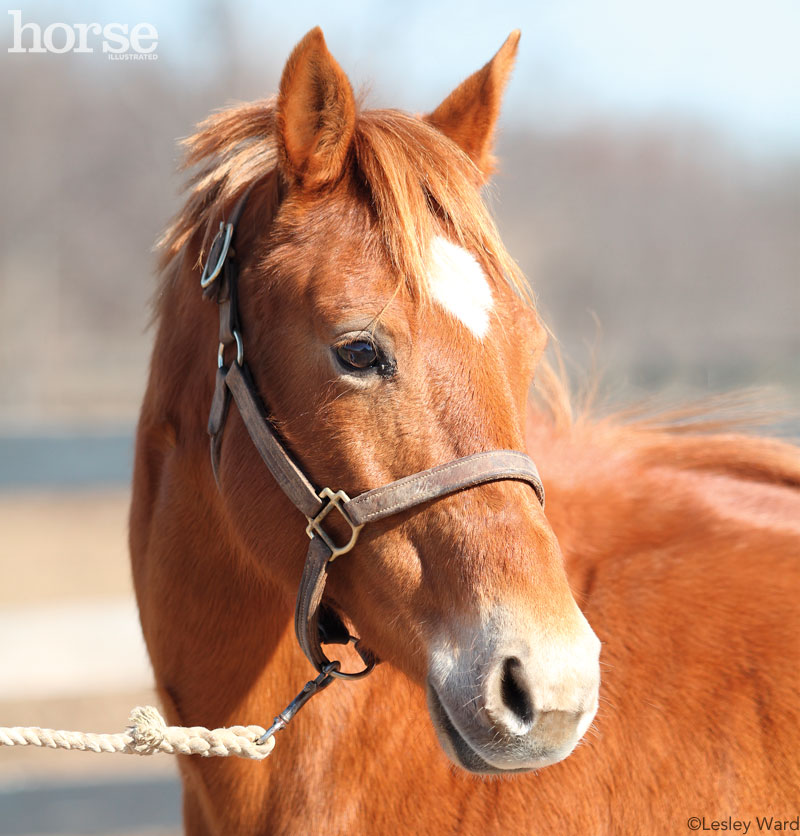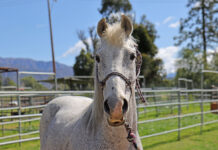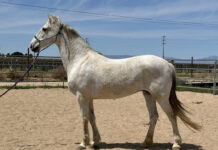
The plight of the unwanted horse continues to haunt most horse lovers. There seems to be no practical one-size-fits-all solution to ensure that every serviceably sound horse has a suitable home. If it weren’t for the dedicated souls who run equine rescues, there’d be even more cast-off horses sent to slaughterhouses.
A Vet’s Viewpoint
Jennifer Voltz, DVM, has a veterinary practice located in the inland region of Southern California. The combination of rural acreage, miles of equestrian trails and proximity to several major racetracks means she sees both ends of the unwanted horse issue.
“Virtually every month someone tries to give me a horse,” says Voltz. “Either they can’t afford the upkeep anymore or they can’t (or won’t) pay to treat an illness or injury—which can be frustrating from my standpoint. So I refer them to one of the reputable rescue organizations that are in our area.”
Voltz sometimes presents another option. “I’m reluctant to say this publicly, but yes, I’ve taken a few horses myself, provided the necessary treatment, and then found them good homes later. In fact, I have three in my backyard right now.”
Due to the proliferation of unwanted horses in the area, she also has clients who adopt horses. “Sometimes the story has a happy ending and we all celebrate, but sometimes it doesn’t,” says Voltz. “That’s unfortunate, because my client’s heart was in the right place. They end up devastated after they’ve invested a great deal of emotion, time and money on a horse that either doesn’t end up being suitable for them or is so unsound that it has to be euthanized.”
To help ensure that more unwanted equines find forever homes, Voltz offers the following tips to anyone about to adopt a horse.
Investigate the reputation and standard practices of the rescue organization.
“The rescue groups that seem to have the most successful adoptions have aligned themselves with a vet who inspects each horse for overall soundness,” says Voltz. “Anything found should be disclosed up front. It shouldn’t have to be a guessing game where it’s dependent upon you to ask if the horse comes with any chronic health or soundness issues.”
Don’t even consider adopting a horse unless you’re prepared to spend both time and money.
“A horse is at a rescue site or up for adoption for a reason,” she says. “If it was surrendered through the legal process due to neglect or abuse that will be obvious, and it takes months, not weeks, to put weight and condition onto a horse. On the other hand, if the horse has come into a rescue looking sleek and well cared for, you have to consider an underlying soundness or behavioral problem. Otherwise, why wasn’t the horse sold or snapped up by a local trainer?”
Consult with your own vet within 24 to 48 hours of adopting a horse.
“Sometimes your vet can be the objective voice of reason, not necessarily to convince you to return the horse, but to help you formulate a nutrition and exercise program that’s best for that particular horse.”
Go easy on the food at first, especially if the horse is in poor physical condition.
“The typical impulse is to continuously shove food at the horse,” says Voltz. “First of all, a thin horse that suddenly ingests large amounts of high-calorie food can colic or founder. Instead, it’s far better to feed several small meals of hay for the first week or two. Then watch to make sure that what goes in comes out. That tells you if the digestive tract is working properly. Eventually you can slowly add feed supplements designed to safely put on weight.”
Fitness is also a work in progress, so don’t plan on any long trail rides, shows or training clinics for a while.
“Some rescue groups have pastures or large open lots where the horses can move around all day, says Voltz. “Others keep their horses in small corrals with minimal turnout time. Either way, the majority of these horses lack condition and their muscles are out of shape. The last thing the horse needs is a soft tissue injury (like a pulled suspensory or bowed tendon) that can take months to heal. So start out with lots of walking interspersed with a few brief minutes of a slow trot or jog. Consult with your vet before you begin more intense exercise, like cantering, hill work or jumping.”
The Adoption Option
Before you follow your heart and tow your trailer to the nearest equine rescue facility, give some serious thought to the challenges involved with adopting a horse. For starters, ask yourself these three questions:
What type of horse am I hoping to get?
Kudos if your goal is to adopt an older pasture pet. Few things in the horse world can be more rewarding than providing a loving home to a senior horse for its final years. In return, most of these old souls will patiently introduce young children to the world of horses. On the other hand, if you’re hoping to find a grand prix jumper for a few hundred dollars, chances are you’ll end up disappointed. Although plenty of fabulous sport horses have been discovered at rescue sites or snatched off slaughter trucks, there are countless others who turn out to be unsound, untalented or simply unmanageable (brain-fried) once they begin regular work.
2. Do I have the skills to work with an unfamiliar or untrained horse?
It’s one thing to leisurely horse shop where you have the luxury of riding the horse several times and often have the opportunity to bring the prospect home on trial. Yet most equine rescue facilities don’t allow visitors to ride their horses on site, primarily due to liability issues. In addition, unlike private sales, many of these horses come with very little verifiable information regarding their previous training. Unless you have advanced horsemanship skills and experience working with green horses, be prepared to pay for some professional mentoring.
Can I afford to rehabilitate a horse in poor condition?
A survey of equine rescue facilities conducted by UC Davis revealed that 53 percent of the horses taken in by these groups were in visibly poor condition. That means you may be adopting a horse that continues to require not just more feed than a healthy horse, but also nutritional supplements. Horses that didn’t receive enough food typically didn’t get regular hoof care, either, so you’ll need to budget for frequent farrier visits and perhaps corrective shoeing. Besides these financial concerns, malnourished and neglected horses often have a lackluster demeanor and seem to yearn for human contact. Be aware that once the horse gains weight and condition, you may witness a startling increase in energy. Behavioral problems may be revealed at that point. Address and correct these issues as you would with any other horse.
Read more in A Tale of Two Adoptions >>
Liked this article? Here are others on horse rescue:
Retraining the Rescue Horse
Horse Rescue Resources
During her lengthy show career on the hunter-jumper circuit, CINDY HALE won more than 20 medals for hunt seat equitation. She currently serves as a judge at local and regional open horse shows.
This article originally appeared in the January 2015 issue of Horse Illustrated magazine. Click here to subscribe!






I think that this author is unfamiliar with the subject. My rescue has neither behavioral, emotional, or performance issues. In fact, for $500 I have received in return a horse that has put smiles on my daughters faces and ribbons in their pocket. She has placed at small shows and big shows. She has done barrel racing, pole bending, saddleseat, dressage, hunter, jumper, been a lesson horse, been a ballerina at a dress up contest, and been the apple of my eye. If your goal is scaring people so that they turn up their nose at even looking into a rescue then you have done a good job. If your goal is to write a balanced article expressing the pros and cons then you should try again. Oh wait, damage done.
I agree with Melissa.
Most rescues actually do work with their horses: riding, training, etc. Horses that are available for adoption have been worked with at-length as well as brought back to adoptable condition. Granted some of them have a few health issues that are more long-term, but those usually become permanent residents at the rescue facility.
Everyone who has adopted horses from the rescue I work at has been beyond happy with their horses and the main reasons they’ve been returned is if they just didn’t have money to keep any horses any more (not necessarily medical related)or they’re moving away.
Due to the fact that there are so many horses in this world, a great many end up as (example) wonderful family pets who just can’t be kept do to the economy.
All that to say, almost all horses at the rescue barns are left waiting for just the right person. So if you’ve read this article and now have second thoughts about adopting a rescue, please don’t! Any horse may not work well with any person just because they aren’t the right match.
I agree that medically, a lot of rescues were discarded because of this and ended up there. But it’s not like there’s a fine line between broken-down, and flashy-but-flawed. There are so many horses in between.
Anyways there’s my 2 cents…
I run a horse rescue in Canada, outside Ottawa, and I would have to disagree with most of what has been said in this article.